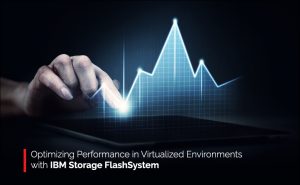
Realizing the true benefits of server virtualization is thwarted when the underlying data center infrastructure is not virtualized. The mobility of virtual machines is limited when a datastore in the virtualization domain is tied to a physical storage system and its management is limited when it is dictated by a monolithic storage element such as an LUN. Achieving virtualization across every element of the IT environment, with the goal of automated management and improved service delivery via software is the next step toward a software-defined data center.
Unfortunately, legacy infrastructure stacks do not provide this level of data virtualization. The resulting environment is complex and costly to manage.
But while underlying data architectures have changed very little, IT’s role in business has changed dramatically. IT—and the data it’s assigned to protect—is at the core of almost all business today. As such, the demand on IT is ever-increasing. To address the demand, IT has been forced to deploy a variety of technologies to solve disparate challenges in the data center. The last decade has been witness to a wave of specialty devices—such as disk-based backup, SSD storage acceleration devices, and cloud gateways—each independently delivering value, but collectively adding to the complexity crisis.
A new approach was needed to resolve the challenges and complexities. It would
- Simplify the infrastructure, service delivery, and the management of resources and workloads.
- Increase application performance and IT agility.
- Improves the ability to scale easily within single sites and across distributed sites.
- Offer resiliency.
- Provide efficiencies that will lower costs and increase IT productivity
- Enable mobility within and across data centers and the cloud.
HPE SimpliVity Hyperconverged Infrastructure
Hewlett Packard Enterprise simplifies IT with true hyperconverged infrastructure. It helps eliminate the complexity and cost of deploying and running virtualized workloads. HPE SimpliVity is a software-defined hyperconverged infrastructure solution that runs on x86 industry-standard servers to deliver turnkey hyperconverged infrastructure for the software-defined data center. Clustering multiple HPE SimpliVity nodes form a shared resource pool that delivers high availability, mobility, and efficient scaling of performance and capacity. HPE SimpliVity technology assimilates all IT infrastructure and services below the hypervisor into a single, scalable 2U building block. Two or more deployed clusters of HPE SimpliVity building blocks form a federation—a massively scalable pool of shared resources.
The HPE SimpliVity data architecture is a globally aware file system and object store with data optimization techniques and data services. It abstracts data from its underlying hardware, enabling hypervisor, and x86 hardware independence. It shifts policies and management from an infrastructure component orientation, usually LUNs or datastores, to the application workload and virtual machine level.
Data deduplication and compression facilitate mobile data structures. Optimization further helps to manage data intelligently based on the anticipated usage of data by the applications. Deduplication is the process of reducing disk workload, replication bandwidth, and storage capacity by eliminating redundant data and retaining only one unique instance of the data on disk. Deduplication helps deliver a lightweight, mobile data structure and, therefore, is key to solving the complexity crisis by addressing the root cause.
Compression is the process of reducing the size of a given data set, providing a more condensed format. It provides complementary value to deduplication by further reducing the disk workload, replication bandwidth, and storage capacity.
Optimization is the intelligent treatment of data on disk based on its anticipated use by an application. Systems that can identify file types and make real-time decisions about where to store that data can achieve overall improved storage efficiency, performance, and bandwidth usage.
Deduplication, compression, and optimization have several key benefits that address the core requirements of today’s data center:
- Bandwidth reduction—Deduplicating, compressing, and optimizing all data and keeping it in this state when transferring to a remote site makes the transfer itself more efficient and saves significant bandwidth resources.
- Data mobility—A fundamental principle of server virtualization is the mobility of VMs, but the data structures which are not optimized can significantly block mobility in a traditional infrastructure environment due to their size. When the data is deduplicated and compressed, it is easier to create point-in-time copies, move VMs from one system to another, and move data to different data centers across the globe.
Deduplicating, compressing, and optimizing data at inception, once and forever, would seem the right approach. When data is deduplicated across all tiers (primary and backup) right from the point of inception, it has significant resource-saving results throughout the data lifecycle.
The HPE SimpliVity Data Virtualization Platform performs deduplication, compression, and optimization in real-time, as the data is first written to the datastore.
The HPE OmniStack Accelerator Card handles the heavy lifting, delivering the required processing power without the high costs. It’s a uniquely architected PCIe module that processes all writes and manages the compute-intensive tasks of deduplication and compression and allows the x86 CPUs to run customers’ business applications.
HPE SimpliVity infrastructure has built-in data protection that performs VM-level backup and bandwidth-efficient replication to further simplify IT operations. It includes efficient data transfer across remote data centers and enables powerful protection and recovery methods. Robust data protection policies for VM backups use simple rules that define backup frequency, backup retention, and backup destination. Backup and replication policies set at the VM-level automate services, helping eliminate costly manual intervention.
Thus, this simplified and lower cost infrastructure platform delivers on requirements of scalability, flexibility, performance, data mobility and cloud integration that today’s modern Hybrid IT demands.
The benefits of HPE SimpliVity Data Virtualization Platform are greater operational efficiency and agility, reduced risk, at better economics with lowered TCO.
Pentagon takes pride in supplying the country’s first HPE Simplivity Solution to a leading Automotive manufacturing company based in Mumbai.
By,
Vivek Pandit
Sr Solution Architect





